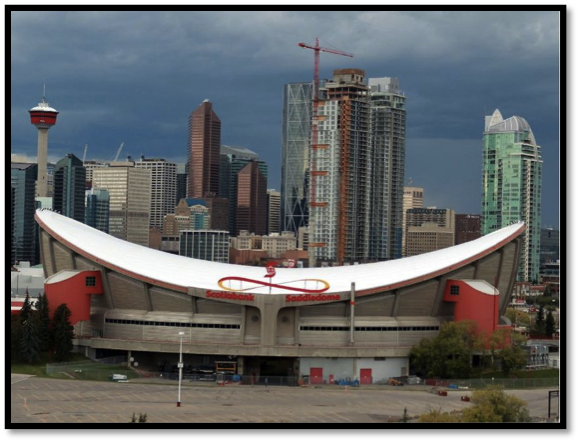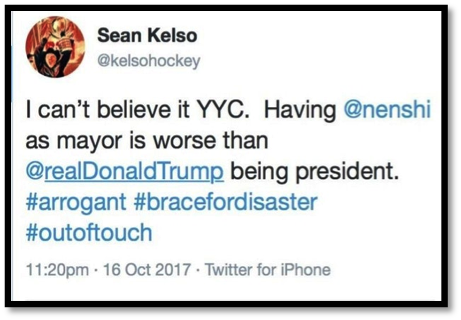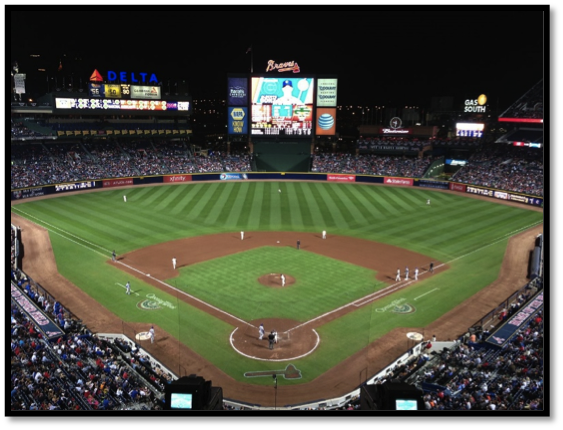Editor's Note: Ryan Gauthier is Assistant Professor at Thompson Rivers University in Canada. Ryan’s research addresses the governance of sports organisations, with a particular focus on international sports organisations. His PhD research examined the accountability of the International Olympic Committee for human rights violations caused by the organisation of the Olympic Games.
Publicly Financing a Stadium – Back in the Saddle(dome)
Calgary, Canada, held their municipal elections on October 16, 2017, re-electing Naheed Nenshi for a third term as mayor. What makes this local election an interesting issue for sports, and sports law, is the domination of the early days of the campaign by one issue – public funding for a new arena for the Calgary Flames. The Flames are Calgary’s National Hockey League (NHL) team, and they play in the Scotiabank Saddledome.

Scotiabank Saddledome, credit to Lorraine Hjalte, Calgary Herald
The team began play in 1972 as the Atlanta Flames, moving to Calgary in 1980. The Saddledome was built in 1983 to support both the newly-arrived Flames, and Calgary’s 1988 Winter Olympic Games. Today, the Saddledome is the oldest arena in operation in the NHL. Due to its age, and the damage caused by floods in 2013, the Flames are looking for a new home. As is the norm in North America, the Flames have no intention of going it alone, but are seeking a deal with the City of Calgary where the city would subsidize part of the arena. Negotiations have been ongoing for several years, with a few possible sites discussed.
Shortly into the 2017 municipal election campaign, negotiations between Calgary and the Flames broke down. The City of Calgary publicly released their proposal for a $555 million stadium, where the city would effectively subsidize 33% of the stadium through a mix of funding, land, and demolition of the old Saddledome. The team would pay 33% of the costs, and the fans would kick in the final 33% through a ticket tax. The Flames responded by releasing their proposal for a $500 million stadium, where the city would provide 45% of the funding through a ‘Community Revitalization Levy’ (a loan from the province of Alberta, paid off by property taxes on new developments around the arena), with the team providing 55% of the remainder. The difference in costs may be that the Flames’ proposal does not appear to consider the demolition of the old Saddledome. While the team’s proposal has the team paying more costs up-front, it would also see the Flames pay no property tax or rent during their tenure in the new stadium, while keeping all revenue generated by the arena.
Canadian national media praised Mayor Nenshi for not simply capitulating to the demands of the Flames. Print media exhorted taxpayers to “Just say ‘No’” to subsidizing the Flames, and called Nenshi’s re-election “a win for every city blackmailed by a sports team”. The Calgary Flames, and the NHL were less sanguine, as NHL Commissioner Gary Bettman blamed Nenshi for not getting a new arena for the Flames, and Flames’ management suggesting that the team would have to move. The night of Nenshi’s re-election saw the communications director of the Flames, Sean Kelso, take a more direct stance:

The ongoing dispute in Calgary is emblematic of a larger problem in North America – the public financing of stadiums for professional sports teams.
Public Financing of Stadiums in North America – A General Overview
North American cities have subsidized stadiums for professional sports teams for decades. However, cities rarely simply transfer cash to a team. Instead, more complex mechanisms are used: issuing bonds, tax increases, lotteries, and the use of “eminent domain”.
First, cities may provide money for stadiums through providing bonds to team owners. These bonds are tax-exempt, and are normally used by cities for public improvements. Cities have been able to justify their use for stadiums, and the tax-exempt nature of the bonds lowers the lifetime borrowing costs for a team. Second, cities may simply increase taxes. Cities used to increase property taxes to raise money for stadiums, but local residents began to resent such increases. Today, cities often increase “sin taxes” (e.g., on alcohol, or gambling), or taxes on hotels, in an attempt to move the burden of increased taxation to out-of-town people who won’t be voting in the next municipal election. Third, cities may set up lotteries, in conjunction with the state or province, to raise money for the stadium. Finally, cities may exercise their use of “eminent domain”. This tactic enables cities to condemn the land, with payment of just compensation (which is often not market value) to the original owner, for the furtherance of a “public purpose” (what constitutes a public purpose is broad, following the US Supreme Court decision in Kelo v. City of New London, 545 U.S. 469 (2005)).
After understanding the what, the question remains: why do cities subsidize sports stadiums? Ultimately, there is a limited supply of major-league teams, and cities view being a “major league” city as a benefit. Unlike European professional leagues, where any local team could make it to the top league through promotion, the top leagues in North America are closed leagues, currently limited to 30-32 teams in the “big four” leagues. Cities that want to be home to a professional team must convince a league to expand, placing a new team in their city (as Las Vegas recently did with the NHL), or convince an owner of an already-existing team to relocate (as Las Vegas has done with the National Football League’s Oakland Raiders). One way to encourage expansion or relation is to offer a subsidized stadium. It can be argued that these tactics are no different than a city offering a subsidy to convince a company to establish or relocate an office – like what is happening with Amazon right now – except for the scale of the subsidy.
Boosters of stadium subsidies have argued that cities should be happy to have sports teams, as the teams will generate an economic boost. They claim that the team, and their new stadium, will increase local income, employment rates, property values, and the well-being of citizens. However, economists have generally debunked these claims. While there are examples of successful stadiums, they are generally not as successful as predicted, often not worth the costs, and the few successes are drowned out by every other instance where the economic impact was not realized (sort of like hosting the Olympic Games or FIFA World Cup).
Proposed Legal Solutions to Halt Public Financing of Stadiums
Given the lack of economic benefits generated by stadiums, particularly given the hundreds of millions of dollars of subsidies granted to each stadium, legal scholars have proposed legislative, regulatory, and judicial solutions to halting this gravy train.
In regards to legislative solutions, Canada and the United States could follow the model of the European Union (EU). The EU has restrictions on government assistance to private industries, to prevent the distortion of competition across the EU – these are known as the “State Aid” rules, found in Art. 107 of the Treaty on the Functioning of the European Union. In practice, the EU has an uneven history of applying the State Aid rules to sport. However, it has shown more enthusiasm over the past year to find evidence of state aid that is incompatible with the Treaty, including in a case that involved a questionable deal involving land next to Real Madrid’s Bernabéu Stadium. However, legislative solutions are unlikely to be enacted by either the American Congress or the Canadian Parliament (or local legislative bodies). There appears to be no interest to do so, and why would there be? Politicians can benefit from new stadiums by working with business elites who support the stadiums, and the evidence of repercussions at the ballot box appear to be mixed.
Some legal scholars have suggested regulatory or judicial solutions, such as: halting the tax-free status of municipal bonds, ending the use of eminent domain to obtain land for stadiums, and advocated a stronger role for antitrust oversight over the conduct of teams and leagues in this regard. However, courts have construed these particular laws broadly enough to allow the public financing of stadiums to continue.
A Good Governance Approach to the Public Financing of Stadiums – Atlanta Braves Case Study
When even Calgary’s stance, which had the city subsidizing at least 1/3 of the stadium, is considered brave, it seems reasonable to presume that publicly-subsidized stadiums will continue apace in North America. As such, it may be more helpful to consider what happens after a stadium project is proposed. Applying a good governance approach to stadium financing could be a helpful way forward. If stadiums are going to be built, regardless, then it is best to make those who build stadiums – governments and teams – accountable to the taxpayers and fans.
Good governance principles have been increasingly applied to the organization of sport – particularly the governance of international sporting organisations. While good governance can be defined in a myriad of ways, it is often broken down to particular principles. In examining stadium projects, I suggest that four principles should be considered: transparency, public participation, solidarity, and review. These principles closely track those used by the Sports Governance Observer.
One recent stadium project seems to have studiously avoided all of these principles entirely – in a way that demonstrates the need for these principles to be applied in the first place. This project took place in the Calgary Flames’ old home of Atlanta, USA.

Turner Field, credit to Zpb52
In 2013, the Atlanta Braves announced that they were leaving their current stadium in downtown Atlanta. They weren’t moving to a new city, but were moving 32 kilometres north to the suburb of Cobb County. The reason for the move? A brand new, publicly-financed stadium. The Atlanta Braves had played at Turner Field since 1997. Not even twenty years later, the stadium, originally built as the centrepiece of the 1996 Summer Olympic Games, was deemed to be obsolete by the Braves. Enter Cobb County. To pay for a new stadium for the Braves, Cobb County issued $368 million in municipal bonds (originally estimated at $276 million). The Braves, in chasing public money, bucked the trend of teams moving closer to the city centre, as suburbs are not conducive to stadiums.
While the rationale and the dollar figure should raise some eyebrows, the process used to secure funding for the stadium should be deeply disturbing to fans of democratic processes. The deal itself was negotiated in secret between a single Cobb County commissioner, and the Atlanta Braves. The president of the Atlanta Braves, John Schuerholz, stated that if news of the deal “had leaked out, this deal would not have gotten done…If it had gotten out, more people would have started taking the position of, ‘We don’t want that to happen. We want to see how viable this was going to be.’” Eventually, the deal needed to be voted on by Cobb County commissioners. At the public vote held in May 2014, only twelve speaking slots were available to the public. Stadium supporters had lined up by 2pm for the 7pm meeting, and the Commissioners denied any additional speaking slots. The same Commissioners voted 5-0 to fund the stadium. Opponents of the stadium filed a suit in the Georgia courts, alleging that the bonds used to finance the new stadium violated the Georgia state constitution, and various state laws. However, the opponents were defeated in the courthouse, too, as the Georgia Supreme Court upheld the validity of the bonds as they provided at least some plausible public benefit. The stadium opened in 2017 to positive reviews from fans and ballpark enthusiasts.
In examining the Atlanta Braves new ballpark by applying principles of good governance, the results are discouraging. Transparency was almost non-existent throughout most of the process, as the deal was completed in secret, as admitted by the president of the team. Public participation was curtailed throughout the process, and most galling, at the eve of the final vote on the funding. There have been no solidarity benefits that have come to the forefront, although it should be noted that it is possible that money that was raised to pay for public parks was diverted to funding the stadium, which cuts against the idea of solidary benefits. Finally, there will likely be no post facto review of the stadium and any attendant benefits it may claim. While there was review of the deal itself through the courts, the Georgia Supreme Court noted that “we do not discount the concerns Appellants have raised about the wisdom of the stadium project and the commitments Cobb County has made to entice the Braves to move there. But those concerns lie predominantly in the realm of public policy….”.

SunTrust Field, Credit to David Goldman/AP
The Value of Good Governance Principles in the Stadium Debate
The case of Atlanta demonstrates the importance of good governance in the public financing of stadiums. Proponents, critics, and scholars can apply these principles to evaluate and engage in more thoughtful debates over the processes of public financing of stadiums. Since stadiums are likely to receive public funding, regardless of the merits, a better process should improve the benefits to the public, while constraining the costs.
Applying principles, as opposed to enacting legislation, may lead the reader to ask “can these principles be enforced?” In terms of traditional legal enforcement, namely recourse to a regulatory body or a court, a city would probably need to implement these terms into a Memorandum of Understanding with the team. For principles such as solidarity, particulars could be written into the final funding agreement. This has been done, for example, with the Community Benefits Agreement implemented between the City of Edmonton, and the Edmonton Oilers hockey team, for a publicly-subsidized stadium that opened in 2016.
However, even if the city itself refuses to implement these principles, they do provide a framework to hold decision-makers to account. In instances where the government has done wrong by the citizens, but there are no judicial remedies, the remedy is then to vote the government out. In establishing these principles, they then provide standards by which the government can be held to account, if not formally, then at least through the ballot box.